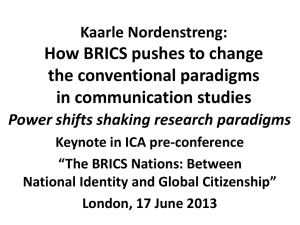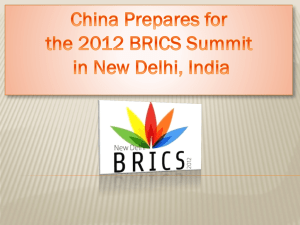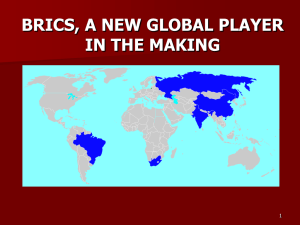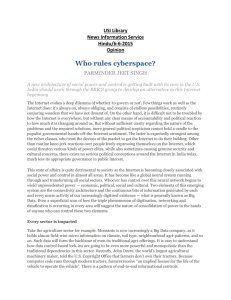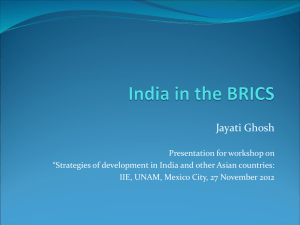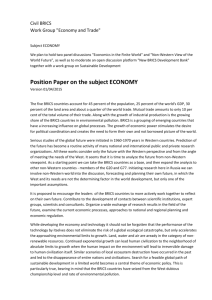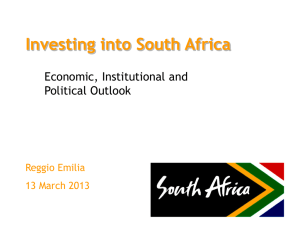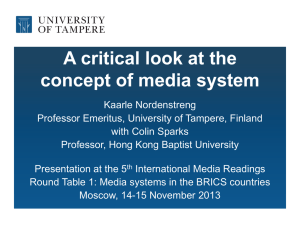Impact of BRICS alliance on South African Economy - Econ
advertisement
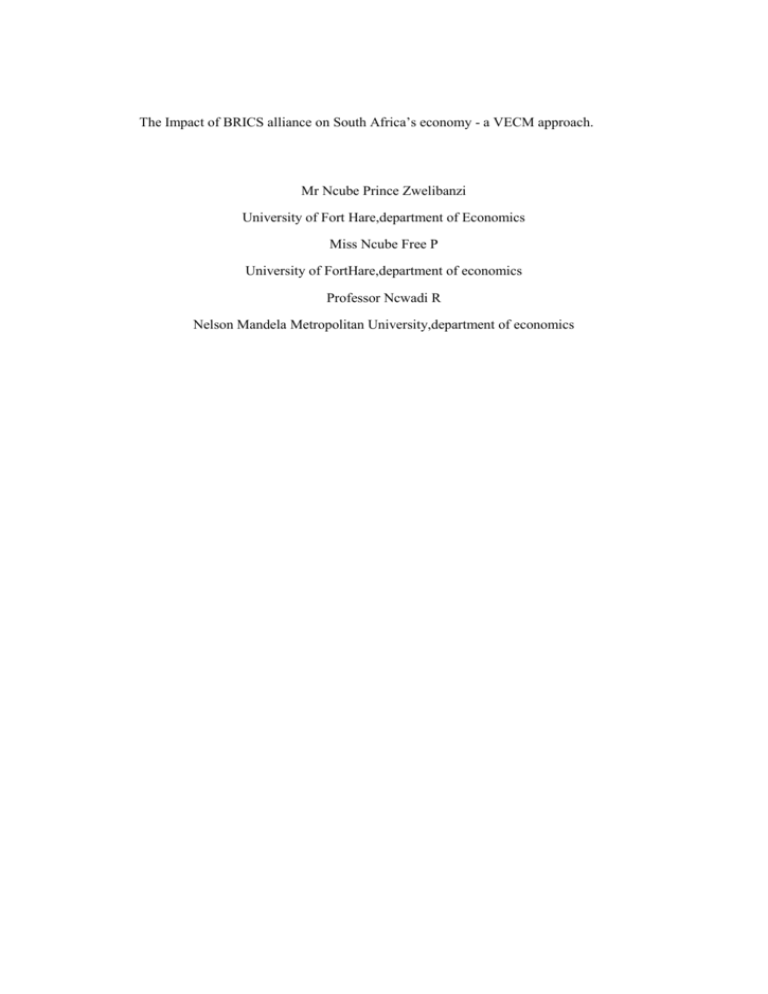
The Impact of BRICS alliance on South Africa’s economy - a VECM approach. Mr Ncube Prince Zwelibanzi University of Fort Hare,department of Economics Miss Ncube Free P University of FortHare,department of economics Professor Ncwadi R Nelson Mandela Metropolitan University,department of economics ABSTRACT This paper examines first the impact of the BRICS alliance on South Africa’s economy and secondly the impact that trade openness in the alliance has on South Africa’s economy. The study uses series data from 1980 to 2012 and employs up to date econometric methodologies- unit root and vector error correction model estimates to achieve its aims. The empirical result reveals that international trade has contributed a lot to the high economic growth rates experienced by the BRICS economies during the recent decades. However, it is also found that international trade is not the only contributing factor. Human Capital formation, Gross domestic capital formation and real effective exchange rate appreciation are equally important contributors. Results of the study however reveal that South Africa’s trade openness in the alliance has detrimental long run effects for the economy .The study also reveals that despite the growth experienced overall in the alliance, South Africa’s economic participation is limited due to unfair trade practices amongst the members of the alliance. The findings provide an insight of the policies to be adopted to achieve higher growth rates in South Africa within BRICS alliance. Keywords: Trade openness, Growth, BRICS, Unit Root, Vector Error Correction Model. i CHAPTER ONE 1. INTRODUCTION 1.1. BACK GROUND OF THE STUDY BRICS, originally "BRIC" before the inclusion of South Africa in 2010, is the title of an association of emerging national economies: Brazil, Russia, India, China and South Africa. According to the UNRussia report (2012:48) with the possible exception of Russia, the BRICS members are all developing or newly industrialized countries, but posses’ distinct large, fast-growing economies and high influence on regional and global affairs. The World Trade Organization(WTO) points out that the five BRICS countries represent almost 3 billion people about 43% of the world population, with a combined nominal GDP of US$14.9 trillion, which is about 25% of the world’s GDP and an estimated US$4 trillion in consolidated foreign reserves and about 11% of the world’s foreign direct investment. Presently, South Africa holds the chair of the BRICS group. According to Wilson and Purushotaman (2010), BRICS economies will possibly become world economic powers in the next 50 years. It is believed that BRICS economies will be larger than the elite group of the worlds’ six richest nations (G6) economies in US dollar terms in the next 40 years and that by 2025 it will nearly be half of the G6 countries’ size. However, Jenkins (2013) argues that this imposes on South African producers the challenge of dealing with a source of foreign competitiveness that is additional to the productive conditions within each country in the BRICS. It is further argued that this is arbitrary on South Africa considering that South Africa has higher trade openness than any of the other BRICS nations yet they make access to their markets difficult since preference is granted among countries in a given region such as Asia for China and India, South America for Brazil .These intra-regional preferences are also believed to force South African exporters to face higher barriers than those imposed on competitors from other countries (ibid,2013). 2 CHAPTER TWO 2.0LITERATURE REVIEW 2.1 INTRODUCTION 2.2.2 Classical economists According to classical economists, foreign trade promotes growth in two ways. The first implies the optimal distribution of resources and productivity which leads to higher growth. Secondly countries are said to have recourse to basic raw inputs and capital goods, which they ordinarily cannot produce. This is believed to equip them with tools domestic growth. EMPERICAL LITERATURE With regards to empirical investigation, empirical studies regarding the link between trade and economic growth in the BRICS economies are scant. However, there have been some studies conducted to investigate the contribution of international trade to growth individually in these economies. Significant though, is the study by Polodoo (2008), who examined the degree to which international trade has contributed to the economic growth enjoyed by the BRICS economies. The study used panel data from 1990 to 2010 and employs econometric methodologies such as unit root testing and the Vector Auto regression (VAR) model. The empirical results reveal that international trade has contributed a lot to the high economic growth rates culminated during the recent decades. However, it also found that international trade is not the only contributing factor. Human Capital formation (HC), Gross Domestic Capital Formation (GDFCF) and exchange rate appreciation are equally important contributors. 3 CHAPTER THREE 3 METHODOLOGY, ESTIMATION AND INTERPRETATION OF RESULTS 4.6.5.1 Vector Error Correction Model (VECM) The discovery of a co integration equation in the previous section implies that a VECM can be used. This allows us to distinguish between the long and short run impacts of variables so as to establish the extent of influence that changes in independent variables in the BRICS alliance has on South African GDP. Using the outcomes from the co integration test the VECM shall be specified. The VECM results are presented in tables’ 11(a) and 11(b). Table 11(a): Results of the long run co integration equation Variable Coeffecient Standard error t stat Consatant 0.264770 SA_GDP(-1) 1.000000 θTO(-1) -0.514321 0.06822 -7.53877 θNFDI(-1) 0.206023 0.14215 1.44936 θHCF(-1) 70.49986 10.0962 6.98282 θGDP(-1) 0.249736 0.11845 2.10842 θGDCF(-1) -1.393295 0.20914 -6.66203 θEXCH(-1) 0.049185 0.01068 4.60698 R-squared: 0.588 Adj. R-squared: 0.438; F-statistic: 3.934; Log likelihood:-61.6121.Akaike AIC: 4.556; SchwarzSC: 4.971Meandependent:-0.0935; S.D.dependent:2.7983 The long run impact of key independent variables on the countries’ economic growth as shown by table 6.0 is illustrated using: GDPSA=0.26+0.05EXCH-1.39GDCF+70.5HCF+0.21NFDI-0.51TO+0.25GDP (BRICS)... Equation above suggests that a percentage increase in θ GDP(BRICS) increases GDP of South Africa by approximately 0.25(ceteris paribus),possibly as a result of “spill-over effects” that come with globalization. Furthermore, the results suggest that a percentage increase in θ T.O in BRICS alliance decreases GDP of South by approximately 0.51(ceteris paribus), this long run effect implies that goods and technology from the BRICS alliance flood domestic markets in South Africa, thus possibly having lower prices than domestically produced goods as a result of lower production costs and other economies 4 of scale and scope in the other BRICS economies. Measures such as tariff and embargoes on South African products by other BRICS members could also be the cause of this .A percentage increase in θ NFDI in the alliance increases South African GDP by at least 0.21 which could be a derived benefit from the foreign investments made by the rest of the world in other BRICS economies. A percentage increase in θ HCF increases South African GDP by 70.5, which is the largest impact. This could be as a result of the realization of return on investments in education, health and standards of living in the other BRICS members, thus increasing their economic active population and productivity which ten benefits South Africa in the long run. Yet a percentage increase in the θ real effective exchange rate EXCH in the alliance leads to a 0.26 increase of the South African GDP. This could be as a result of the appreciation value gained by the alliance currencies against the US dollar, which then benefits South Africa in the long run. Table 11(b) Error correction results Variable D(SA_GDP) D(θTO) D(θNFDI) D(θHCF) D(θGDP) D(θGDCF) D(θEXCH) Coeffecient -0.781125 -0.084654 -0.347221 -0.004747 -0.374162 0.207307 -1.211776 Standard error 0.23434 0.16600 0.23564 0.00157 0.22285 0.09128 1.31734 t-statistic -3.33335 -0.50996 -1.47350 -3.02026 -1.67897 2.27103 -0.91987 The table above 11(b) shows that the coefficient of D (SA GDP), that is -0.78 shows that the speed of adjustment is approximately 78 per cent. This implies that if there is a deviation from equilibrium, 78 per cent is corrected in one year as the variable moves towards restoring equilibrium. Therefore, this means that there is strong pressure on South African GDP to restore long run equilibrium whenever there is a disturbance. This speed of adjustment is statistically significant with an absolute t-value of approximately 3.333. The high speed of adjustment by the South African GDP may reflect the existence of some positive factors affecting GDP in South Africa. These factors include the increase in level of education, positive changes in demographic factors, ideal monetary and fiscal policies as well as foreign policy, among others. On the other hand the coefficient of D(θTO), that is -0.008 shows that the speed of adjustment is approximately 8 percent. This implies that if there is a deviation from equilibrium, only 8 percent is corrected in one year as the variable moves towards restoring equilibrium. Therefore this means that there is no strong pressure on θTO in BRICS to restore long run equilibrium with South African GDP. The impact of this is that South Africa’s economic growth is being adversely affected both in the short and long run by the trade openness in the alliance. This implies that South Africa imports more than it exports to the BRICS, thereby increasing its trade deficits and possibly long term liabilities in terms of balance of payments with BRICS alliance. Importing of goods could lead the erosion of the domestic markets specifically when there is trade deficit occurrence i.e. the import is higher than the export. Some of the goods like cars, textile chicken and appliances that are often imported lead a higher loss of jobs in the respective markets. The South African domestic industries can also be crippled due to the imports from BRICS countries where the wages and other cost of production are generally lower than South Africa’s. This causes domestic industries not to compete since they cannot lower prices of goods than the cost of goods and also they have the obligation to the worker union to offer a minimum wage. 5 CONCLUSIONS AND POLICY RECOMMENDATIONS However it is pointed out that in terms of the balance of trade, South Africa has run a trade surplus with Russia in the last two years of R1.3 billion and R1 billion respectively, after running trade deficits in 2008 and 2009,whilst South Africa runs a trade rising deficit of nearly $1 billion with Brazil. The country's biggest trade deficit is with China, a figure that reached a high $4 billion last year(2012).However, after running trade surpluses with India of R2.5 billion in 2009 and R1.5 billion in 2010, South Africa in 2012 recorded a trade deficit of R4.9 billion with India for example terms of the impact of Chinese competition on South African manufacturing and industrial employment, one has to consider the share of Chinese(12%) and other imported products in the total consumption of manufactured goods. The increased openness of the South African manufacturing sector and the economy as a whole over the past two decades (1993 to 2013) has exposed it to increases of import penetration which can largely be attributed to China. Estimation results revealed that average gross domestic product in the BRICS alliance (θGDP (BRICS)) has a positive impact on the South African economy. The results also showed that average trade openness in the alliance (θTO) negatively affects South Africa’s economy. On the other hand the average net foreign direct investment (θNFDI) in the alliance has a positive impact on the South Africa’s economy, whilst the average human capital formation (θHCF) and the average real effective exchange rates (θ EXCH) have positive impact on the South African economy. However, the average gross domestic capital formation (θGDCF) in the alliance has a negative impact on South Africa’s economy. 4.6.6 Trade and industry policy The long run equation however suggested that South Africa’s trade openness in the alliance has a negative impact on South Africa’s economy. However, theory is in not in agreement as to the weather trade liberalization or trade protectionism promotes or limits economic growth. Using the impact of trade openness on South Africa’s economy as prescribed by theory as well as the coefficient of trade openness from the long run equation suggested by VECM results, it implies that a 1 unit rise in θ trade openness would lead to a 0.51 decrease in the level of economic growth in the South African economy. Therefore, to improve the South African economy, trade openness in the alliance should be lowered. However, this remedy is only applicable if all the domestic industry is stimulated and the domestic prices are competitive and the infant industries are given optimal terms protecting them against foreign multinationals who already benefit from low production costs, economies of scale and economies of scope are collectively grouped and treated as an aggregate Also a significant number of the ten industries with the highest level of Chinese import penetration are traditional labor intensive sectors such as textiles and clothing, footwear, leather products and furniture. Chinese competition in these industries therefore likely to have a severe adverse impact on domestic employment especially of unskilled workers and is likely 6 REFERENCES Aghion. P and Howitt. P., (1992): “A Model of Growth through Creative Destruction” Econometrica, Vol. 60, No. 2. (Mar., 1992), pp. 323-351 Andrés MS et al., (2013) ‘What drives FDI from non-traditional sources? A comparative analysis of the determinants of bilateral FDI flows’, Economics, 7, 2013-1 Bassanini, Andrea, and Stefano Scarpetta.,(2001) “Does Human Capital Matter for Growth in OECD Countries? Evidence from Pooled Mean-Group Estimates,” OECD Economics Department Working Paper No. 282 (Paris: OECD). Bhorat, H., (2006) “Economic growth is necessary but not sufficient” South African Journal of Economics vol. 74 pg 442-462. Brooks, C., (2002). “Introductory Econometrics for Finance” Cambridge University. Chow, P. C. Y., (1987). “Causality between export growth and industrial development”: empirical evidence from the NICs. Journal of Development Economics, Vol. 26, pp: 55–63. De Abreu Campanario M et al (2012) ‘Foreign Direct Investment:Diagnosis and Proposals for a Brazilian Public Policy’,Internext – Revista Eletrônica de Negócios Internacionais da ESPM. Dunning .JH.,(1981) ‘The determinants of international production’, Oxford Economic Papers, New Series, 25,3, 1973, pp. 289 –336; Dunning JH, ‘Toward an eclectic theory of international production: Some empirical tests’,Journal of International Business Studies. Eurostat, EU-27 (2010) Foreign Direct Investment in BRIC Countries. Data in Focus, 29/2010. Luxenbourg: European Commission. Feder, G., (1982). “On export and economic growth”. Journal of Development Economics 12: 59-73. Heckscher .E., (1919). "The Effects of Foreign Trade on the Distribution of Income," Ekonomisk Tidskrift, Vol. 21, pp. 497-512. Helpman, E. (1981). “International trade in the presence o f product differentiation, economies of scale, and monopolistic competition”: A Chamberlin-Heckscher-Ohlin approach, Journal of International Economics. 11, 305-340. Hlouskova J and Wagner. M., (2005): “The performance of panel unit root and stationary tests”, EUI Working Paper ECO No 2005/5. Hondroyiannis & P.A.V.B. Swamy & George S. Tavlas & Michael Ulan., (2005). "Some Further Evidence on Exchange-Rate Volatility and Exports," Working Papers 28, IMF. Iqbal, M. S., Sheikh, F. M., & Shar, A. H., (2010). Causality Relationship between Foreign Direct Investment, Trade and economic Growth in Pakistan.Asian Social Science Journal,06 Jenkins.R., (2012):”Chinese competition and the restructuring of the South African Manufacturing”, University of East Anglia developmental Journal, page 1-6. 7 Khan, M. A.,(2007). Trade Liberalization, Financial Development and Economic Growth.Pakistan Institute of Development Economics working Paper Krugman, P. R., (1979). "Increasing returns, monopolistic competition, and international trade," Journal of International Economics, Elsevier, vol. 9(4), pages 469-479, November. Kuznetsov A., (2011) ‘Outward FDI from Russia and its Policy Context, Update 2011’. Columbia FDI Profiles. Lee, J. W., (1993). “International trade, distortion and long-run economic growth”, International Monetary Fund Staff paper, 40(2):299-328. Levesque G.,(2012) ‘Here’s what’s driving China’s investments in Africa’, Business Insider Online. Magoraty, M., (2013):”The political economy”, Wall street Journal, 4-13. Mankiw, N.G & Romer. D & Weil. D.N., (1992). "A Contribution to the Empirics of Economic Growth," The Quarterly Journal of Economics, MIT Press, vol. 107(2), pages 407-37, May. Mlachila M & M Takebe.,(2011) ‘FDI from BRICs to LICs:Emerging growth driver?’, IMF Working Paper WP/11/178.Washington, DC: IMF. Nidugala, G.K., (2001), “Export and Economic Growth in India: An Empirical Investigation”, Indian Economic Journal, 47(3): 67–78 Ohlin, Bertil., (1933).“Inter-regional and International Trade” Harvard University Press, 1933. Polodoo,V., (2012) ‘Trade and Economic Growth- A perspective from BRICS nations and Implications for Developing World’, Mauritius University Press. Ricardo, D., (1817)-’On the Principles of Political Economy and Taxation (1817)’- 3rd edition by Batoche Brooks Kitchener 2001 Romer, P.M., (1986): “Increasing Returns and Long Run Growth”, Journal of Political Economy, 94, 1002–37. Smith.A., (1776) ‘An Inquiry into the nature and causes of the Wealth of Nations’, London, Methuen and Co Ltd, 5th edition . Edwin Cannan, 1904. Sun SL et al., (2012) ‘A Comparative ownership advantage framework for cross-border M&As: The rise of Chinese and Indian MNEs’, Journal of World Business. Wilson, D. and Purushothaman, R., (2003). “Dreaming with BRICs: The path to 2050”. Global economics paper no. 99. 8
